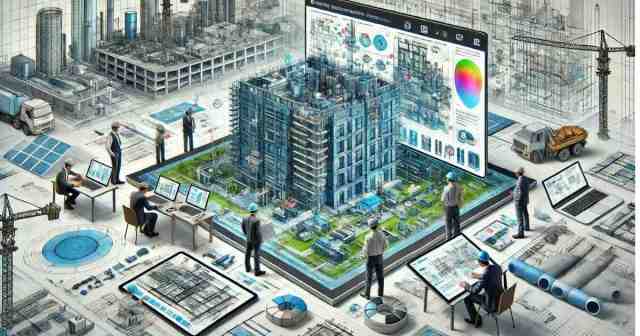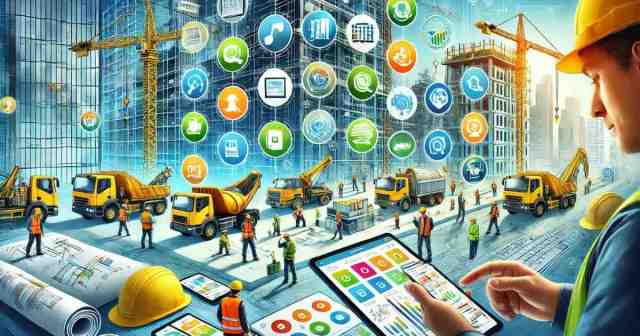The construction industry has traditionally been slow to adopt new technologies. However, with the increasing pressure to improve efficiency, reduce costs, and meet sustainability goals, construction companies are now fully embracing digital transformation. Digital tools and technologies are reshaping how projects are planned, managed, and executed, offering unprecedented opportunities for growth and innovation. In this blog, we’ll explore how digital transformation is taking place in the construction sector, the benefits it offers, and the key technologies driving this shift.
What is Digital Transformation in Construction?
Digital transformation refers to the integration of digital technologies into all areas of construction, changing how companies operate and deliver value to their clients. This involves using tools such as cloud computing, Building Information Modeling (BIM), artificial intelligence (AI), drones, and mobile apps to streamline processes, enhance productivity, and improve communication. The shift towards digital technology in construction has been accelerated by the need for better collaboration, real-time data access, and the overall push toward more sustainable building practices.
Key Areas of Digital Transformation
Building Information Modeling (BIM)

One of the most significant advancements in construction is the use of Building Information Modeling (BIM). BIM allows architects, engineers, and contractors to create digital representations of buildings before they are constructed. These models include not only the physical layout of the building but also important data such as materials, structural details, and energy efficiency parameters. BIM enhances collaboration by enabling all stakeholders to work from the same digital model, reducing the chances of errors and miscommunication during construction. It also allows for better project visualization and planning.
Cloud Computing
Cloud technology is transforming how construction companies store and share information. With cloud-based platforms, data can be accessed from anywhere, which is especially useful for construction sites that are remote or constantly moving. Teams can collaborate in real-time, update project documents, and track progress through digital dashboards. The use of cloud technology also reduces the need for paper-based processes, improving sustainability while enhancing project management efficiency.
Mobile Technology and Apps

Construction managers, workers, and engineers no longer have to rely on paper blueprints or manual data entry. Mobile apps designed for construction management are streamlining daily operations, from tracking time and equipment usage to reporting safety incidents. These apps improve real-time communication and provide instant access to important project details, helping to resolve issues quickly and avoid costly delays.
Artificial Intelligence (AI) and Machine Learning
AI and machine learning are increasingly being used in construction to predict potential issues, optimize workflows, and enhance decision-making. For example, AI can analyze data from past projects to predict delays or budget overruns, allowing project managers to make adjustments before problems arise. AI-driven robots are also being used for tasks such as bricklaying or welding, improving both speed and accuracy in construction.
Drones
Drones are revolutionizing the way construction sites are monitored. They can capture aerial footage and create 3D maps of construction sites, providing real-time information that helps managers monitor progress and identify potential hazards. Drones are particularly useful in surveying large or hard-to-reach areas, making them an invaluable tool for site inspections, safety audits, and progress tracking.
3D Printing
While still in its early stages, 3D printing is expected to become a significant part of construction in the coming years. This technology allows construction companies to print building components directly on-site, reducing waste and speeding up the construction process. The use of 3D printing can also lead to more innovative designs and lower labor costs, as machines take over some manual tasks.
Internet of Things (IoT)
IoT is playing a crucial role in monitoring construction equipment, safety conditions, and project performance. By connecting machinery, sensors, and other devices, IoT provides real-time data that helps managers optimize performance, predict maintenance needs, and ensure worker safety. For instance, IoT-enabled wearables can track the location and condition of workers, reducing accidents and improving site safety.
Benefits of Digital Transformation in Construction
Improved Efficiency
One of the most obvious benefits of digital transformation in construction is improved efficiency. Digital tools such as BIM, AI, and mobile apps allow for better project management, real-time collaboration, and the automation of time-consuming tasks. This leads to faster project completion, reduced labor costs, and fewer delays.
Cost Savings
Digital tools can help construction companies save money in several ways. For example, AI-powered analytics can predict potential project delays, allowing managers to address issues before they become costly problems. BIM reduces the need for costly rework by identifying design flaws early in the process, while cloud-based tools minimize the need for physical storage and printing costs.
Enhanced Safety
Digital technologies such as drones, IoT devices, and mobile safety apps are helping to create safer construction sites. Drones allow for remote site inspections, reducing the need for workers to access potentially dangerous areas. IoT sensors can monitor equipment and alert workers to potential hazards, while mobile apps make it easier to report and address safety incidents in real time.
Sustainability
As the world focuses on more sustainable building practices, digital transformation is making it easier for construction companies to reduce their environmental impact. BIM helps with planning energy-efficient buildings, while digital project management tools reduce the need for paper. IoT sensors can optimize energy use on construction sites, and 3D printing reduces material waste.
Better Collaboration
With cloud computing and digital communication tools, construction teams can collaborate more effectively. Teams in different locations can access the same project data, communicate in real-time, and work together more seamlessly. This improves the overall coordination of projects, leading to fewer errors and more successful outcomes.
Conclusion🎯
Digital transformation is reshaping the construction industry in numerous ways, from improved efficiency and cost savings to enhanced safety and sustainability. With tools like BIM, AI, drones, and IoT, construction companies are moving away from traditional methods and adopting a more modern approach. As the industry continues to evolve, the integration of digital technologies will undoubtedly play a crucial role in its future success.
